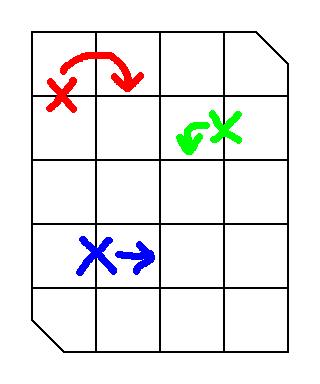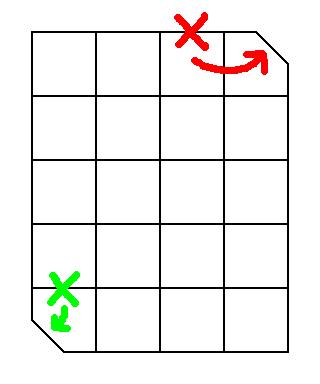Danadazo
By Jared B. McComb

|
IntroductionDanadazo is played on the board shown at right. The game is not played in the cells; nor is it played on the intersections; rather, it is played entirely on the line segments of the board - a feature not found in any other chess variant that I am aware of. The small exception to the rule is that the "bent corners" at the top-right and lower-left that consist of three segments are considered curves and are consequently single spaces. There are then 47 line segments on the board. Danadazo is a game between two unequivalent factions; the Attackers and the Defenders. |

|
SetupThis is the opening setup. The Attackers are represented by the blue-gray pieces, and the Defenders are the dark gray pieces. There are three types of pieces used in this game. The first type are the Pawns. These are the plain circles in the corners of the board. The Attackers have twelve of these, and the Defenders have six. The second type are the Guards, which are represented by a circle with a small dot. These pieces are exclusive to the Defenders, who have six of them. The third type are the Generals. These are the pieces with the large dots. The Attackers have two of these, while the Defenders have one. |

|
DefinitionsMovement on a board such as this creates problems when one tries to use the terms 'orthogonal' and 'diagonal,' so these phrases must be abandoned. I have therefore supplied here three phrases with which to convey the type of movement; the phrases are 'crosspoint,' 'crosscorner,' and 'crosscell.' Each of these words is pronounced as a compound word that starts with 'cross' and ends in another word. Here is an illustration of the three types of movement. The 'X' represents a piece and the arrow shows where the piece is going. Crosspoint movement is movement across an intersection of lines to another segment on the same line - it crosses the point of intersection. (Shown in RED) Crosscorner movement is movement across an intersection of lines to another segment on a perpendicular line - it crosses the angle (or corner) of the intersection. (Shown in GREEN) Crosscell movement is movement from one segment to an adjacent parallel segment - it crosses the cell between them. (Shown in BLUE) |

|
Here is another illustration of movement, with the same colors as before. This time, the movement is relating to the curved corners (also called the bends). Note that there is no such thing as crosscell movement when relating to the bends; it is identical to crosscorner movement. Note also that movement is a two-way concept - if the pieces represented were on the bends, they could move in the direction opposite the arrow instead. |
The Pieces
The Generals may move any distance crosspoint or one space crosscorner. When moving crosspoint, they are permitted to turn using a bend; this is called 'rounding.'
The Guards are the second-most important pieces of the Defenders. They may move one space crosspoint or crosscorner. They may also move one space crosscell, provided that they do not capture when doing so and that there are no enemy pieces adjacent (crosspoint or crosscorner) to the space moved from. The important thing about the Guards is that the Attackers must capture all but one of them before they may capture the General (see below for how to capture).
The Pawns may move one space crosspoint or crosscorner. They are also the only pieces that can form barriers (see below).
Play
The Attackers have the first move. Play then alternates between the two players. This game should be played in pairs; after the first game, the players switch sides. A player wins if they can beat their opponent both times, and a draw is if both players win once or either game is a draw. (If there is a draw on the first game, the match immediately ends.)
Objective
The objective of this game is to capture the opposing General(s). The Attackers must also capture five of the Defender's guards before they can do this. If a player is reduced to a single General, they can also force a draw by evading capture for twenty moves (ten per player), starting with the General's next move. There is no such thing as check in this game; stalemate therefore doesn't exist. A game can also concede in a draw by mutual agreement of both players.
Capture
Capture in this game is done by custodianship, also known as "sandwich capture." The type of piece that is capturing doesn't matter; they all capture the same way and can aid each other in capturing. In custodianship capture, two pieces surround an enemy on opposite sides; the three pieces are always adjacent and always form a straight line. (A capture may, however, use a bend to curve it.) Capture may be done crosspoint or crosscorner. A piece may move in between two enemy pieces to make a "sandwich," and it is safe when doing so. If the Defender's General is "sandwiched" before five guards have been captured, the General is still safe.
Barriers
A barrier is an arrangement of four pawns that surround an intersection on the board. It is not permissible to have Guards or Generals in a barrier. A barrier has no special powers, it is simply forbidden to make a barrier formation containing a non-Pawn piece. If such a move is made, and noticed by the opponent, the move must be withdrawn and the turn forfeited. It is permissible to do so, however, if either:
- The opponent doesn't notice, or
- The player with the barrier will be forced to break it up on their next turn. After their next turn, though, they can't immediately move back to make the barrier again.
Strategy
The Attackers will have to protect their Generals a lot more than the Defender, as the Defender can afford to be reckless with it when he has most of his Guards. The game will start out a little crowded in the beginning, so you will want to capture your opponent's pieces early to free up room to maneuver. It will take a while for beginners to get used to this sort of board, but once you get used to it, it's quite simple to remember.
Acknowledgments
This game was invented by Jared B. McComb as an entry to the 42 Squares contest, but had to be dropped from the contest when it was realized it had 47 places where you could put a piece. It was inspired mainly by Tafl (which could be considered a unirexal variant) and by the following idea:
"In FIDE Chess, the pieces only move in the cells, and in Xiang-Qi, they only move on the vertices. What would it be like to have an 'in-between' variant?"
The name 'Danadazo' is a splicing of two different words -- 'Dada' and 'Nazo'; the first being the name of a weird 'art' style, and the second being, as far as I can tell, Japanese for 'confusing' or 'puzzling'.
Please send all questions, comments, constructive criticisms, better diagrams, computer programs that play this game (freeware only please!), etc., to
Written by Jared B. McComb. HTML Conversion by Peter Aronson.
WWW page created: February 3rd, 2002.
